KIA Sorento 2007 1.G Repair Manual
Manufacturer: KIA, Model Year: 2007, Model line: Sorento, Model: KIA Sorento 2007 1.GPages: 325, PDF Size: 5.01 MB
Page 61 of 325
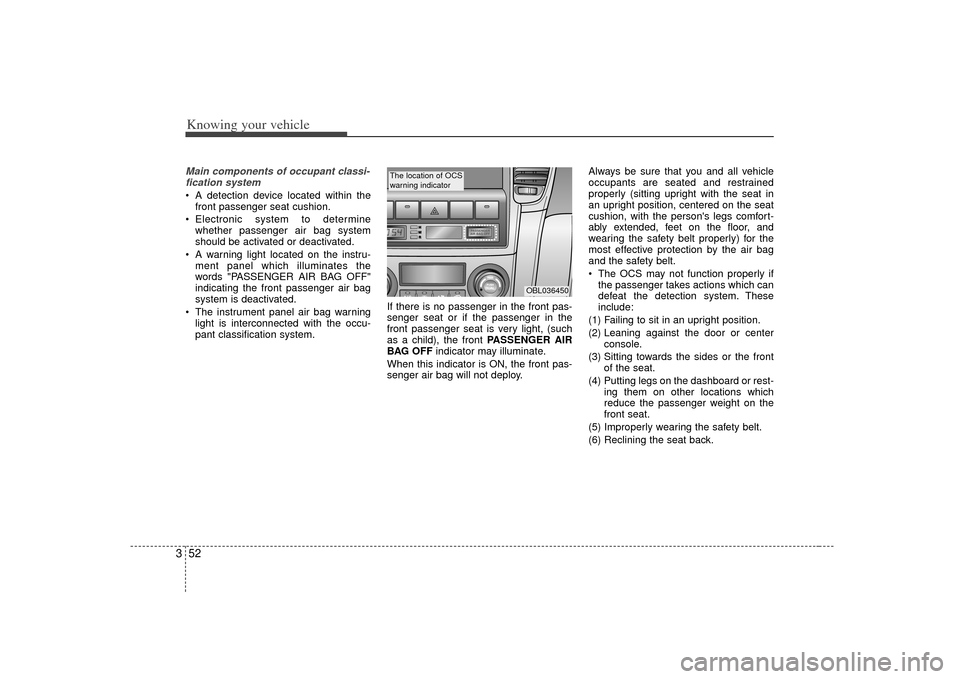
Knowing your vehicle52
3Main components of occupant classi-
fication system A detection device located within the front passenger seat cushion.
Electronic system to determine whether passenger air bag system
should be activated or deactivated.
A warning light located on the instru- ment panel which illuminates the
words "PASSENGER AIR BAG OFF"
indicating the front passenger air bag
system is deactivated.
The instrument panel air bag warning light is interconnected with the occu-
pant classification system. If there is no passenger in the front pas-
senger seat or if the passenger in the
front passenger seat is very light, (such
as a child), the front PASSENGER AIR
BAG OFF
indicator may illuminate.
When this indicator is ON, the front pas-
senger air bag will not deploy. Always be sure that you and all vehicle
occupants are seated and restrained
properly (sitting upright with the seat in
an upright position, centered on the seat
cushion, with the person's legs comfort-
ably extended, feet on the floor, and
wearing the safety belt properly) for the
most effective protection by the air bag
and the safety belt.
The OCS may not function properly if
the passenger takes actions which can
defeat the detection system. These
include:
(1) Failing to sit in an upright position.
(2) Leaning against the door or center console.
(3) Sitting towards the sides or the front of the seat.
(4) Putting legs on the dashboard or rest- ing them on other locations which
reduce the passenger weight on the
front seat.
(5) Improperly wearing the safety belt.
(6) Reclining the seat back.
OBL036450
The location of OCS
warning indicator
Page 62 of 325
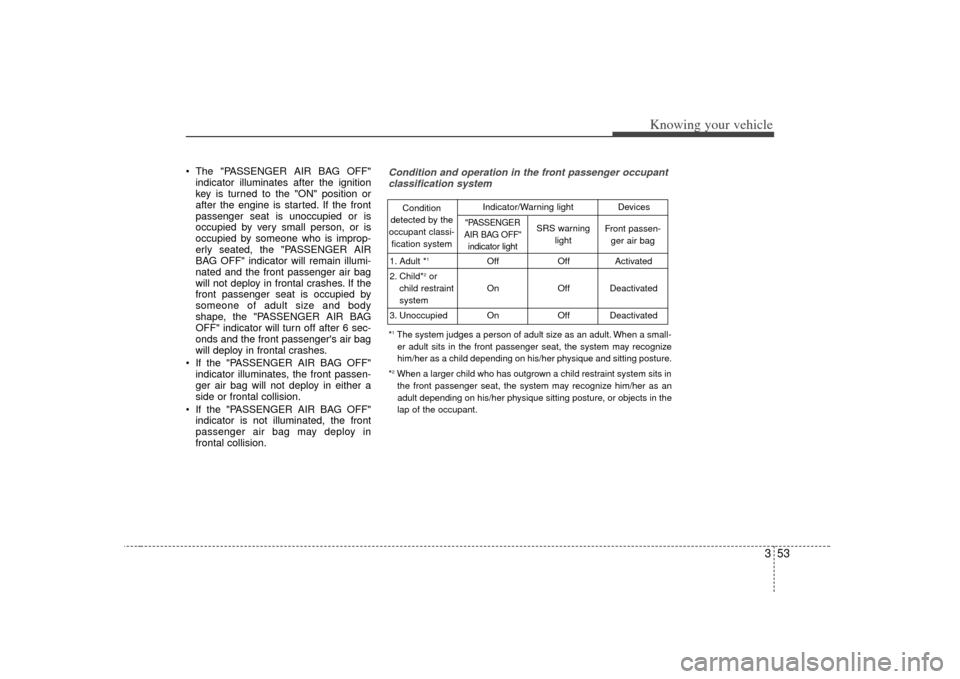
353
Knowing your vehicle
The "PASSENGER AIR BAG OFF"indicator illuminates after the ignition
key is turned to the "ON" position or
after the engine is started. If the front
passenger seat is unoccupied or is
occupied by very small person, or is
occupied by someone who is improp-
erly seated, the "PASSENGER AIR
BAG OFF" indicator will remain illumi-
nated and the front passenger air bag
will not deploy in frontal crashes. If the
front passenger seat is occupied by
someone of adult size and body
shape, the "PASSENGER AIR BAG
OFF" indicator will turn off after 6 sec-
onds and the front passenger's air bag
will deploy in frontal crashes.
If the "PASSENGER AIR BAG OFF" indicator illuminates, the front passen-
ger air bag will not deploy in either a
side or frontal collision.
If the "PASSENGER AIR BAG OFF" indicator is not illuminated, the front
passenger air bag may deploy in
frontal collision.
Condition and operation in the front passenger occupantclassification system*1The system judges a person of adult size as an adult. When a small-
er adult sits in the front passenger seat, the system may recognize
him/her as a child depending on his/her physique and sitting posture.
*2When a larger child who has outgrown a child restraint system sits in the front passenger seat, the system may recognize him/her as an
adult depending on his/her physique sitting posture, or objects in the
lap of the occupant.Condition
detected by the
occupant classi- fication system
1. Adult *
1
2. Child*
2or
child restraint
system
3. Unoccupied Off
On
On Off
Off
OffActivated
Deactivated
Deactivated
"PASSENGER
AIR BAG OFF" indicator light
SRS warning light Front passen-
ger air bag
Indicator/Warning light Devices
Page 63 of 325
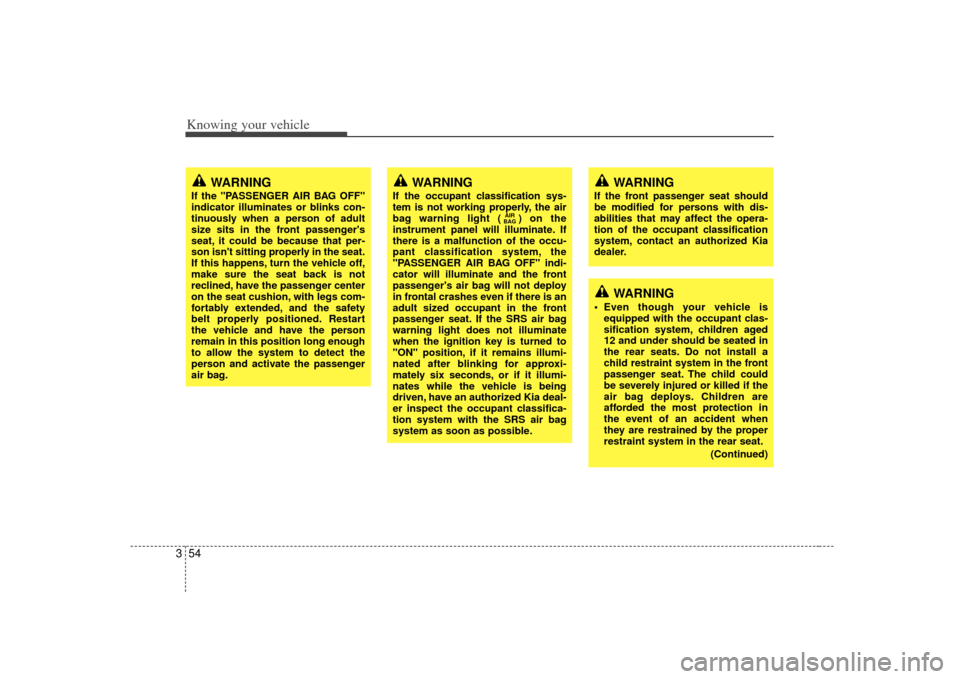
Knowing your vehicle54
3
WARNING
If the front passenger seat should
be modified for persons with dis-
abilities that may affect the opera-
tion of the occupant classification
system, contact an authorized Kia
dealer.
WARNING
If the "PASSENGER AIR BAG OFF"
indicator illuminates or blinks con-
tinuously when a person of adult
size sits in the front passenger's
seat, it could be because that per-
son isn't sitting properly in the seat.
If this happens, turn the vehicle off,
make sure the seat back is not
reclined, have the passenger center
on the seat cushion, with legs com-
fortably extended, and the safety
belt properly positioned. Restart
the vehicle and have the person
remain in this position long enough
to allow the system to detect the
person and activate the passenger
air bag.
WARNING
If the occupant classification sys-
tem is not working properly, the air
bag warning light ( ) on the
instrument panel will illuminate. If
there is a malfunction of the occu-
pant classification system, the
"PASSENGER AIR BAG OFF" indi-
cator will illuminate and the front
passenger's air bag will not deploy
in frontal crashes even if there is an
adult sized occupant in the front
passenger seat. If the SRS air bag
warning light does not illuminate
when the ignition key is turned to
"ON" position, if it remains illumi-
nated after blinking for approxi-
mately six seconds, or if it illumi-
nates while the vehicle is being
driven, have an authorized Kia deal-
er inspect the occupant classifica-
tion system with the SRS air bag
system as soon as possible.
AIR
BAG
WARNING
Even though your vehicle is
equipped with the occupant clas-
sification system, children aged
12 and under should be seated in
the rear seats. Do not install a
child restraint system in the front
passenger seat. The child could
be severely injured or killed if the
air bag deploys. Children are
afforded the most protection in
the event of an accident when
they are restrained by the proper
restraint system in the rear seat.
(Continued)
Page 64 of 325
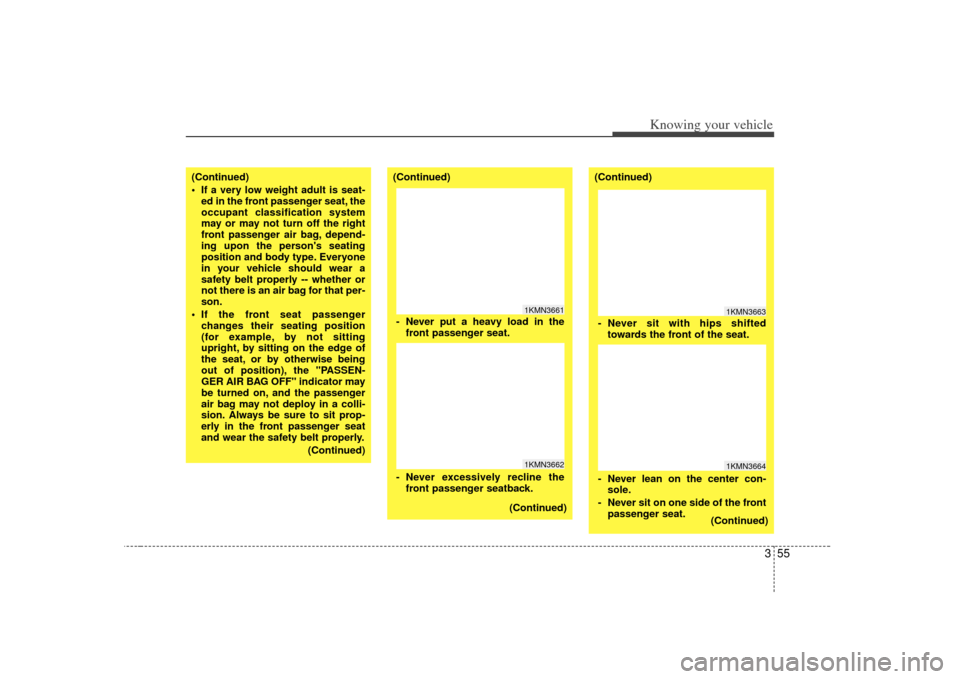
355
Knowing your vehicle
(Continued)
If a very low weight adult is seat-ed in the front passenger seat, the
occupant classification system
may or may not turn off the right
front passenger air bag, depend-
ing upon the person's seating
position and body type. Everyone
in your vehicle should wear a
safety belt properly -- whether or
not there is an air bag for that per-
son.
If the front seat passenger changes their seating position
(for example, by not sitting
upright, by sitting on the edge of
the seat, or by otherwise being
out of position), the "PASSEN-
GER AIR BAG OFF" indicator may
be turned on, and the passenger
air bag may not deploy in a colli-
sion. Always be sure to sit prop-
erly in the front passenger seat
and wear the safety belt properly.
(Continued)
(Continued)
(Continued)
(Continued)
(Continued)
1KMN36611KMN3662
- Never put a heavy load in thefront passenger seat.
- Never excessively recline the front passenger seatback.
1KMN36631KMN3664
- Never sit with hips shiftedtowards the front of the seat.
- Never lean on the center con- sole.
- Never sit on one side of the front passenger seat.
Page 65 of 325
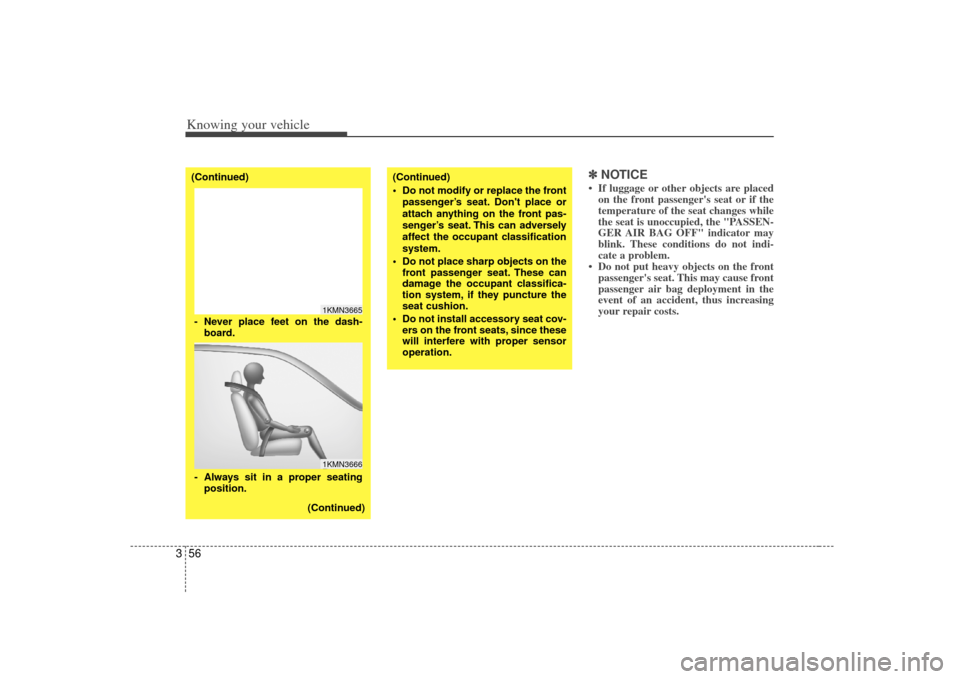
Knowing your vehicle56
3
✽
✽
NOTICE• If luggage or other objects are placed
on the front passenger's seat or if the
temperature of the seat changes while
the seat is unoccupied, the "PASSEN-
GER AIR BAG OFF" indicator may
blink. These conditions do not indi-
cate a problem.
• Do not put heavy objects on the front passenger's seat. This may cause front
passenger air bag deployment in the
event of an accident, thus increasing
your repair costs.
(Continued)
(Continued)
1KMN36651KMN3666
- Always sit in a proper seatingposition.
- Never place feet on the dash-
board.
(Continued)
Do not modify or replace the front
passenger’s seat. Don't place or
attach anything on the front pas-
senger’s seat. This can adversely
affect the occupant classification
system.
Do not place sharp objects on the front passenger seat. These can
damage the occupant classifica-
tion system, if they puncture the
seat cushion.
Do not install accessory seat cov- ers on the front seats, since these
will interfere with proper sensor
operation.
Page 66 of 325
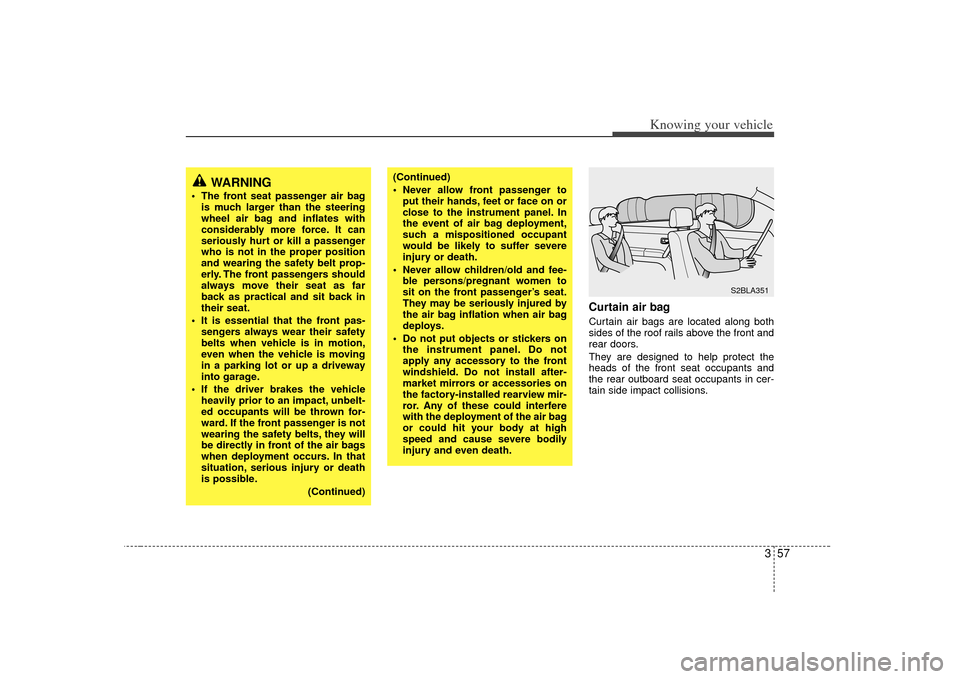
357
Knowing your vehicle
Curtain air bagCurtain air bags are located along both
sides of the roof rails above the front and
rear doors.
They are designed to help protect the
heads of the front seat occupants and
the rear outboard seat occupants in cer-
tain side impact collisions.
WARNING
The front seat passenger air bagis much larger than the steering
wheel air bag and inflates with
considerably more force. It can
seriously hurt or kill a passenger
who is not in the proper position
and wearing the safety belt prop-
erly. The front passengers should
always move their seat as far
back as practical and sit back in
their seat.
It is essential that the front pas- sengers always wear their safety
belts when vehicle is in motion,
even when the vehicle is moving
in a parking lot or up a driveway
into garage.
If the driver brakes the vehicle heavily prior to an impact, unbelt-
ed occupants will be thrown for-
ward. If the front passenger is not
wearing the safety belts, they will
be directly in front of the air bags
when deployment occurs. In that
situation, serious injury or death
is possible.
(Continued)
(Continued)
Never allow front passenger toput their hands, feet or face on or
close to the instrument panel. In
the event of air bag deployment,
such a mispositioned occupant
would be likely to suffer severe
injury or death.
Never allow children/old and fee- ble persons/pregnant women to
sit on the front passenger’s seat.
They may be seriously injured by
the air bag inflation when air bag
deploys.
Do not put objects or stickers on the instrument panel. Do not
apply any accessory to the front
windshield. Do not install after-
market mirrors or accessories on
the factory-installed rearview mir-
ror. Any of these could interfere
with the deployment of the air bag
or could hit your body at high
speed and cause severe bodily
injury and even death.
S2BLA351
Page 67 of 325

Knowing your vehicle58
3 The curtain air bag deployment occurs
only on the side of the vehicle affected
by the impact.
The curtain air bags are not designed to deploy during collisions from the
front or rear of the vehicle or in most
rollover situations.
The curtain air bags are designed to deploy only during certain side-impact
collisions, depending on the crash
severity, angle, speed and impact.
(Continued)
Do not allow the passengers tolean their heads or bodies onto
doors, put their arms on the
doors, stretch their arms out of
the window, or place objects
between the doors and passen-
gers when they are seated on the
seats where curtain air bags are
equipped.
Never try to open or repair any components of the curtain air bag
system. This should be done only
by an authorized Kia dealer.
Failure to follow the above men-
tioned instructions can result in
severe injury or death to the vehicle
occupants in an accident.
WARNING
In order for the curtain air bags to provide its best protection, both
front seat occupants and both
outboard rear occupants should
sit in an upright position with the
safety belts properly fastened.
When children are seated in the rear outboard seats, they must be
seated in the proper child
restraint system. Make sure to put
the child restraint system as far
away from the door side as possi-
ble, and secure the child restraint
system in position.
(Continued)
Page 68 of 325
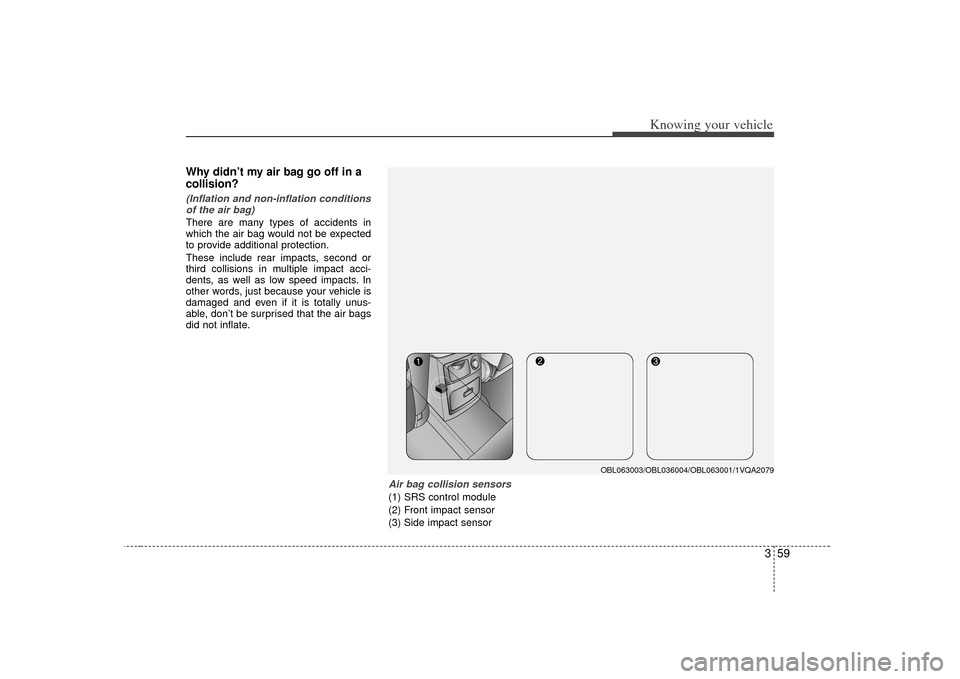
359
Knowing your vehicle
Why didn’t my air bag go off in a
collision? (Inflation and non-inflation conditionsof the air bag)There are many types of accidents in
which the air bag would not be expected
to provide additional protection.
These include rear impacts, second or
third collisions in multiple impact acci-
dents, as well as low speed impacts. In
other words, just because your vehicle is
damaged and even if it is totally unus-
able, don’t be surprised that the air bags
did not inflate.
Air bag collision sensors(1) SRS control module
(2) Front impact sensor
(3) Side impact sensor
OBL063003/OBL036004/OBL063001/1VQA2079
Page 69 of 325
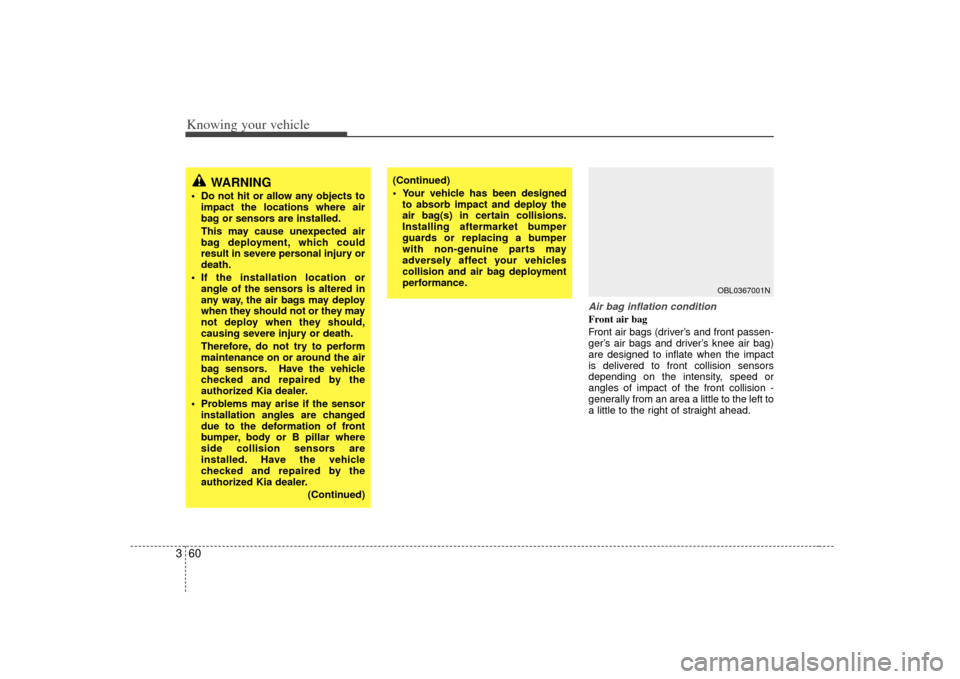
Knowing your vehicle60
3
WARNING
Do not hit or allow any objects to
impact the locations where air
bag or sensors are installed.
This may cause unexpected air
bag deployment, which could
result in severe personal injury or
death.
If the installation location or angle of the sensors is altered in
any way, the air bags may deploy
when they should not or they may
not deploy when they should,
causing severe injury or death.
Therefore, do not try to perform
maintenance on or around the air
bag sensors. Have the vehicle
checked and repaired by the
authorized Kia dealer.
Problems may arise if the sensor installation angles are changed
due to the deformation of front
bumper, body or B pillar where
side collision sensors are
installed. Have the vehicle
checked and repaired by the
authorized Kia dealer.
(Continued)
(Continued)
Your vehicle has been designedto absorb impact and deploy the
air bag(s) in certain collisions.
Installing aftermarket bumper
guards or replacing a bumper
with non-genuine parts may
adversely affect your vehicles
collision and air bag deployment
performance.
Air bag inflation conditionFront air bag
Front air bags (driver’s and front passen-
ger’s air bags and driver’s knee air bag)
are designed to inflate when the impact
is delivered to front collision sensors
depending on the intensity, speed or
angles of impact of the front collision -
generally from an area a little to the left to
a little to the right of straight ahead.
OBL0367001N
Page 70 of 325
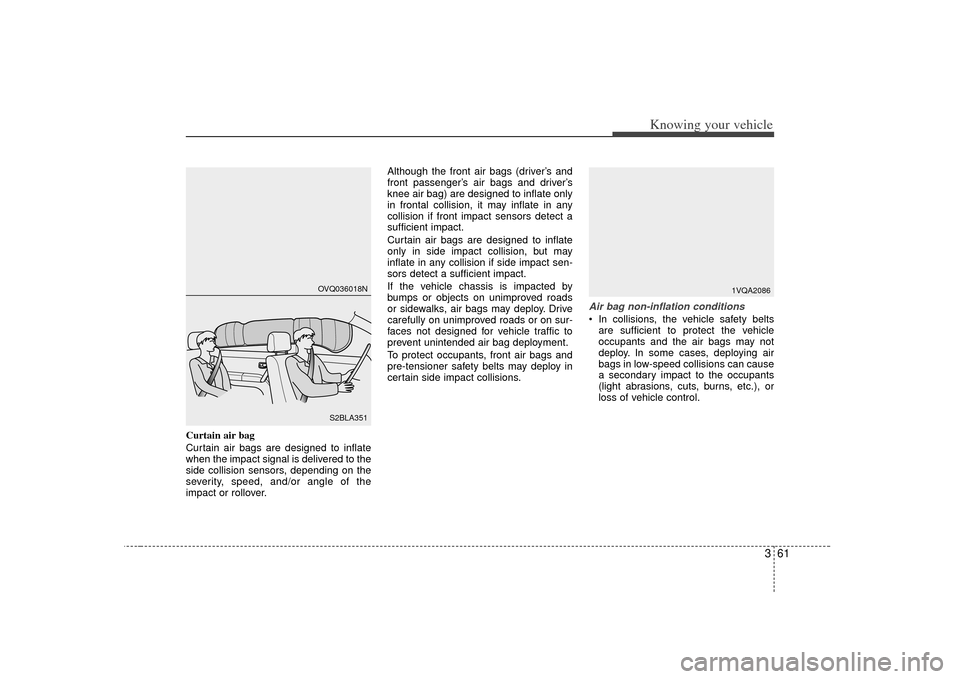
361
Knowing your vehicle
Curtain air bag
Curtain air bags are designed to inflate
when the impact signal is delivered to the
side collision sensors, depending on the
severity, speed, and/or angle of the
impact or rollover.Although the front air bags (driver’s and
front passenger’s air bags and driver’s
knee air bag) are designed to inflate only
in frontal collision, it may inflate in any
collision if front impact sensors detect a
sufficient impact.
Curtain air bags are designed to inflate
only in side impact collision, but may
inflate in any collision if side impact sen-
sors detect a sufficient impact.
If the vehicle chassis is impacted by
bumps or objects on unimproved roads
or sidewalks, air bags may deploy. Drive
carefully on unimproved roads or on sur-
faces not designed for vehicle traffic to
prevent unintended air bag deployment.
To protect occupants, front air bags and
pre-tensioner safety belts may deploy in
certain side impact collisions.
Air bag non-inflation conditions In collisions, the vehicle safety belts
are sufficient to protect the vehicle
occupants and the air bags may not
deploy. In some cases, deploying air
bags in low-speed collisions can cause
a secondary impact to the occupants
(light abrasions, cuts, burns, etc.), or
loss of vehicle control.
OVQ036018N
S2BLA351
1VQA2086